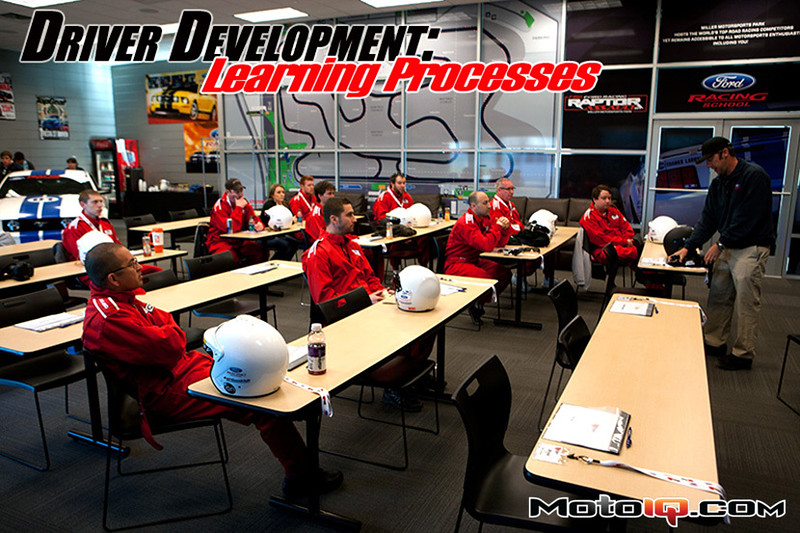2 – RIDING WITH AN INSTRUCTOR
One of the first and most basic forms of the driver learning process is riding with an instructor and observing. In a racing school, or early in one’s track-driving career before being signed off to drive ‘solo’, an instructor will often drive the car and perform an exercise or demonstrate the driving line. This method is great since it allows the student to feel what the car is doing, see the steering inputs, and get a firsthand experience of what they need to replicate. It is also the most primitive form of learning and can be credited as the method by which everything we have learned since infancy, from speech to walking, by copying our parents. Monkey-see, Monkey-do.

While this method is great when introducing something new or fundamental, there are some limitations. First off, the student needs to drive the car and work on the exercise or maneuver themselves and watching someone else doing it over and over won’t inherently make them more proficient at it. This is why many racing schools only have their instructors briefly demonstrate a technique and spend most of the time giving feedback.
As a student advances and the gap between the student and instructor gets smaller, they have already seen the correct steering inputs, have felt the way the car moves around, and have felt the limit of what the car can do. Unless there are new techniques to be learned, there really isn’t much of a benefit from watching someone do what you are already able to do. At this point, a better instructor who can drive the car at a higher level will increase the gap from student to instructor and will potentially be more beneficial; however riding with an instructor still has its limitations.
3 – DRIVING WITH AN INSTRUCTOR
The next step is driving the car with an instructor riding in the right seat. This method allows for instantaneous feedback and is substantially more beneficial in the advancement of the driver. The instructor can feel the car move around, anticipate and know where the limit of traction is to encourage or discourage the driver to push harder, go faster, when to brake, and how to improve their driving inputs. This can be very helpful in learning new experiences, like car control, a new car, or a new track. It also enables the instructor gauge where you are at speed wise (usually relative to their own ability, so it’s important to find a good instructor) and what you need to work on.

Like riding with an instructor, driving with an instructor also has its limitations as the student to instructor gap decreases. A big part of driving at the limit is the feedback through the steering wheel, pedals, g-force through the seat of the pants, visual and sound cues. As a passenger, an instructor only has three of the five aspects to feel what is happening. If the car does not have a good racing seat for the passenger, it becomes even more difficult for an instructor to provide accurate feedback for a proficient student. As the driver advances, the additional weight of a 150-200lb instructor will become more noticeable and will negatively affect the handling characteristics and outright speed of the car.
I remember having to be signed off by a lead club racing instructor to be able to privately coach a client during an open track day, even though I was already an instructor for one of the largest racing schools in the country. I had to drive the car fast to demonstrate my ability and while taking it easy and driving at 9/10ths, the instructor signing me off was extremely nervous and didn’t like my driving. Once I backed it down to 7/10ths snail’s pace with the same line but without having the car move around at all, he was more comfortable, praised my driving, and signed me off to instruct. My 9/10ths was probably his 11/10ths and he couldn’t make sense of it. So when trying to improve your craft, it’s important to find the best instructor you can afford or try to link up with the best free instructor at a track day since right-seat feedback is subjective and is usually determined and limited by the abilities of the instructor. It also becomes less beneficial as the gap from student to instructor is reduced.

Top level coaches are going to charge a lot to ride in the right seat since their livelihood usually depends on their ability to race competitively and they will need to be compensated accordingly for the risk they are taking. Their life really is in your hands. The recent deaths of driving coaches in crashes is a wakeup call for professional coaches to value their life accordingly and be selective on the student’s talent, speed, attitude, car and safety equipment that they are working with. This is a really good reason to have your safety equipment from racing seats to harnesses in the passenger seat up to the same standards as your driver’s seat.
While there are some really good free instructors that like to give back to the community for self-edification or in exchange for free seat time for themselves, there are many others who should be avoided. Anyone and their mom can be called ‘instructors’ these days and they step up to the plate for free track days and for the demand of basic instruction at events. Often these instructors preach bad habits and under-driving cars (turning-in to corners on throttle) out of their own self-preservation, at a level below their own talents and ability. When a driver finds themselves at a plateau in their driving ability, they will need to find someone more advanced to take them to the next level, and it will often cost money. But if going faster is the name of the game, improving the driver might be a better return on investment than buying that $5,000 set of coilovers to replace your probably sufficient $2,000 coilover. Improving the driver is the best mod you can do.




3 comments
What is ur takes on karting to cars? Is practicing karts help racing cars? And what are the skills transferred from karts to cars.
Karting is excellent for racecraft and seat time. However, Karts don’t have suspension, and the dynamics of a car moving around on springs and dampers bring a lot of complexity that Kart’s don’t really help prepare for. Most professional drivers started in Karts and moved into Formula style cars, which is a more natural transition than from say, Karts into sedan racing.
Overall, it’s very helpful (especially racecraft) but not a necessity.
Great article Billy! Your support of motorsports at the amature/hobbiest level is much appreciated. Ive been watching my own videos recently and am picking up things I never realized, mostly a lack of consistency in braking. Understanding that all the aspects of driving the car are interdependant, I am nonetheless trying to prioritize the things that need correction. It seems I would gain more speed focusing on corner exit and thus entry and braking prior to the turn. Am I correct in working backwards? Your thoughts are appreciated and thanks again!